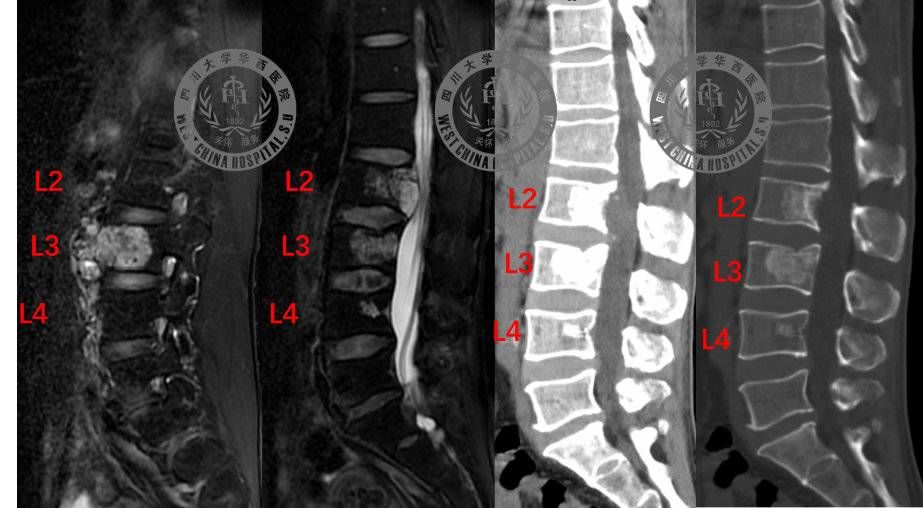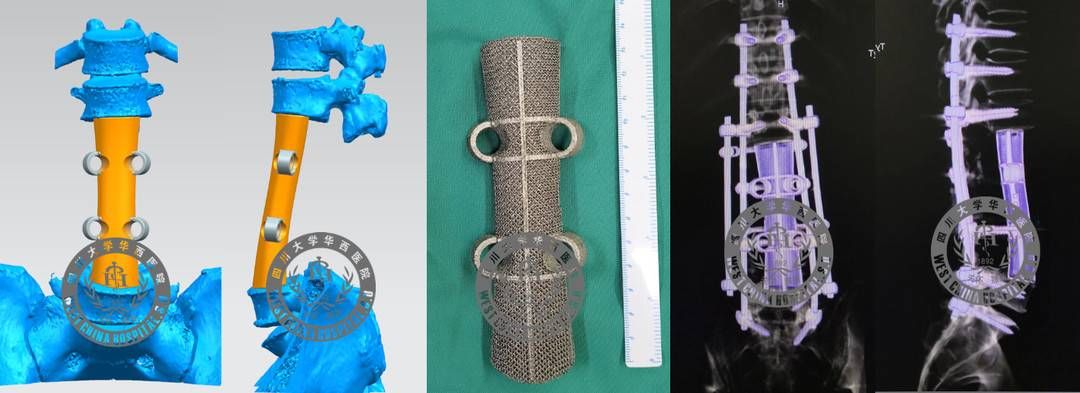Cover reporter Qiu Tian
On May 8, a 47-year-old patient, Mr. Li, was discharged from the West China Hospital of Sichuan University. Recently, the team of Professor Li Tao from the Orthopedic Spine Surgery Center of the hospital removed Mr. Li’s tumor-covered lumbar vertebra en bloc, and used 3D printing technology to reconstruct the artificial vertebral body for him, which minimized the risk of tumor recurrence and preserved him. Features.
This is the first lumbar multi-segment total vertebral en bloc resection in Southwest China with 3D printing individualized artificial vertebral body replacement reconstruction surgery.
Professor Li Tao’s team, in conjunction with multidisciplinary departments such as vascular surgery, anesthesiology, operating room, ICU, and rehabilitation, successfully completed a world-class operation with a total of 22 hours in two phases.
Middle-aged man suffers from chordoma
Mr. Li is 47 years old, 7 months ago, because of lower back pain , Seek medical attention for numbness and pain in the anterolateral side of the right thigh. After a series of examinations, it was found that Mr. Li had chordoma on the 2nd, 3rd, and 4th vertebrae of his lumbar spine.
Among them, the tumor of the lumbar 2 vertebra grew into the spinal canal, which has compressed the spinal nerve in the spinal canal, resulting in damage to the conus cauda equina; the tumor of the lumbar 3 vertebra grew into the abdominal cavity, forming a huge soft tissue mass.
Chordoma is a rare malignant tumor that occurs in the skull base, spine and sacrum. The incidence rate is about 0.8 cases/1 million people/year. The 5-year survival rate is only about 30%.
Because chordoma is prone to local infiltration and invasion, and is not sensitive to traditional radiotherapy and chemotherapy, surgery is the main treatment method. However, it is very easy to relapse after surgery, and once it relapses, it often leads to incontinence, paralysis of the lower limbs and even death. Therefore, whether the initial surgery can completely remove the tumor is the key to the treatment of chordoma.

For Mr. Li, there are only 5 lumbar vertebrae, 3 of which are affected by tumors, which is equivalent to The tumor has invaded 3/5 of the entire lumbar spine. En bloc resection of 3 vertebrae is almost the only hope for the patient to be rescued.
However, the operation is very difficult. First, in order to minimize tumor recurrence, en bloc resection of the entire vertebra is required, and the difficulty lies in the need to completely separate the vertebral interosseous structures. The spine is located in the back and center of the body, with complex surrounding anatomical structures, many vital organs and organs, adjacent to the largest blood vessel in the human body, and contains important spinal nerve structures. The operation is full of risks. En bloc resection is also the most difficult and technically demanding operation in the field of spine surgery. Only a few top hospitals in China can perform this type of operation.
Secondly, the tumor involved a long and wide range of lumbar vertebrae; in different segments, the tumor broke through the bony compartment to form a huge soft tissue mass in the spinal canal and paravertebral, with a wide range of involvement.
Meanwhile, tumor resection alone is not enough. Because after the resection, the length of the spinal defect of the patient is very large, and the defect site is the axial bone with the greatest stress load in the human body. The biomechanical environment is complex, and traditional titanium meshes, supports and other implants are prone to fracture and displacement.
How to preserve spinal nerve function is also a major difficulty. The patient had obvious damage to the conus cauda equina before the operation, indicating that the spinal nerve and other compression by the tumor had reached the limit. In the limit state of the spinal nerve, it is difficult to completely preserve the function of the spinal nerve by performing such a huge tumor resection and reconstruction operation.
The operation time of world-class difficulty is 22 hours
Facing such a case of world-class difficulty, Professor Li Tao’s team carefully designed the operation A three-stage two-stage surgical treatment plan of “posterior approach-anterior approach-re-posterior approach” was adopted.
First, the lumbar 2-4 vertebrae appendages and intervertebral discs were removed through the lumbar back incision, and fixed with pedicle screws and titanium rods to reconstruct the posterior structure of the lumbar vertebrae; then an anterior abdominal umbilical incision was made to separate the inferior vena cava , abdominal aorta and iliac arteries, complete tumor vertebral body exposure and nerve release layer by layer, complete resection of diseased vertebral body and tumor, reconstruction of anterior vertebral body structure; finally, incision from the original incision on the back of the waist to connect the anterior artificial vertebral body And the rear screw rod fixation system to complete the lumbar spine reconstruction.
To this end, Professor Li Tao’s team cooperated with vascular surgery, anesthesiology, operating room, ICU, and rehabilitation departments to carry out multidisciplinary cooperation. The operation lasted for two phases and a total of 22 hours.

3D printed artificial vertebral body design, physical objects and postoperative review pictures< /span>
In order to achieve effective reconstruction of the anterior vertebral body, Professor Li Tao’s team used 3D printing technology to produce an individualized artificial vertebral body. It is individually designed according to the patient’s anatomy and perfectly fits the upper and lower normal vertebral body connection surfaces. The 3D porous titanium alloy printing design provides sufficient biomechanical strength for the artificial vertebral body.
In addition, the screw implantation hole is specially designed, which can connect the artificial vertebral body prosthesis with the rear screw-rod system, forming a unique truss structure, which increases the stability of the artificial vertebral body, so that the patient can be removed as soon as possible. Bed rehabilitation training to achieve life and work like a normal person.
It is understood that this is the first time in Southwest China that 3D printing of individualized long-segment truss structure artificial vertebral bodies has been applied to clinical practice.
After the operation, Mr. Li can get out of bed wearing a lumbar support under the care of medical staff and gradually recover.
Re-examination imaging showed no residual tumor, and the position of internal fixation and artificial vertebral body was good. Mr. Li was successfully discharged from the hospital on May 8.
【If you have news clues, welcome to report to us. Once adopted, you will be paid a fee. Newsletter WeChat Follow: ihxdsb, Newsletter QQ: 3386405712]